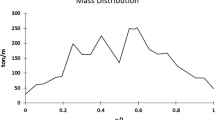Abstract
It is estimated that around 10,000 containers are lost during maritime transportation every year, representing an economic loss to the liner industry. Regulations and norms used to calculate values to secure them to the ship’s deck account for static loads only, neglecting more realistic conditions. This paper describes an approach to simulate a two-tier scaled model of a 20-ft ISO freight container and its linking connectors, denominated twist locks, subject to a dynamical load induced by its base. To analyze this problem two methods were employed: a shaking table test and finite-element analysis. Results of this study indicate that the numerical model built to simulate two-tier container stack dynamics is a promising tool for further studies. Moreover, the model is able to predict conditions close to real situations faced by container stacks while stored on deck.













Similar content being viewed by others
References
Levinson M (2006) The Box: How the shipping container made the world smaller and the world economy bigger. Princeton University Press, Princeton
Podsada J (2010) Lost sea cargo: Beach bounty or junk? Nat Geogr (6)
Zhou Y, Lu X, Lu W, He Z (2009) Shake table testing of a multi-tower connected hybrid structure. Earthq Eng Eng Vib 8(1):47–59
Harris HG, Sabnis GM (1999) Structural modeling and experimental techniques, 2nd edn. CRC Press, Boca Raton, Florida
Nader M (1996) Shaking table tests of rigid, semirigid, and flexible steel frames. J Struct Eng 122:589
Chung W, Yun C, Kim N, Seo J (1999) Shaking table and pseudodynamic tests for the evaluation of the seismic performance of base-isolated structures. Eng Struct 21(4):365–379
Villaverde R, Mosqueda G (1999) Aseismic roof isolation system: analytic and shake table studies. Earthq Eng Struct Dyn 28(3):217–234
Wu Y, Samali B (2002) Shake table testing of a base isolated model. Eng Struct 24(9):1203–1215
Samali B, Wu Y, Li J (2003) Shake table tests on a mass eccentric model with base isolation. Earthq Eng Struct Dyn 32(9):1353–1372
Sun Q, Zhang L, Zhou J, Shi Q (2003) Experimental study of the semi-active control of building structures using the shaking table. Earthq Eng Struct Dyn 32(15):2353–2376
Midorikawa M, Azuhata T, Ishihara T, Wada A (2006) Shaking table tests on seismic response of steel braced frames with column uplift. Earthq Eng Struct Dyn 35(14):1767–1785
Li C, Lam S, Zhang M, Wong Y (2006) Shaking table test of a 1:20 scale high-rise building with a transfer plate system. J Struct Eng 132:1732
Lee H, Ko D (2007) Seismic response characteristics of high-rise RC wall buildings having different irregularities in lower stories. Eng Struct 29(11):3149–3167
Lu X, Fu G, Shi W, Lu W (2007) Shake table model testing and its application. Struct Des Tall Spec Build 17(1):181–201
Fraraccio G, Brügger A, Betti R (2008) Identification and damage detection in structures subjected to base excitation. Exp Mech 48(4):521–528
Chang K, Lin Y, Chen C (2008) Shaking table study on displacement-based design for seismic retrofit of existing buildings using nonlinear viscous dampers. J Struct Eng 134:671
Prasad S, Towhata I, Chandradhara GP, Nanjundaswamy P (2004) Shaking table tests in earthquake geotechnical engineering. Curr Sci 27(10):1398–1404
Taleb-Ibrahimi M, De Castilho B, Daganzo C (1993) Storage space vs handling work in container terminals. Transp Res Part B Methodol 27(1):13–32
Vis I, De Koster R (2003) Transshipment of containers at a container terminal: an overview. Eur J Oper Res 147(1):1–16
Murty K, Liu J, Wan Y, Linn R (2005) A decision support system for operations in a container terminal. Decis Support Syst 39(3):309–332
Stahlbock R, Voß S (2008) Operations research at container terminals: a literature update. OR Spectr 30(1):1–52
Suzuki K, Kirkayak L, Sueoka H, Futaoka Y, Masabayashi K, Ando H (2009) Model test of container lashing dynamic behavior. Conference of the Japan Society of Naval Architects and Ocean Engineers—JASNAOE, vol 8, pp 465–466
Kirkayak L, Suzuki K, Sueoka H, Aguiar VS, Masabayashi K, Ando H (2009) Dynamic simulation of container lashing behavior. Conference of the Japan Society of Naval Architects and Ocean Engineers—JASNAOE, vol 8, pp 467–468
Kirkayak L (2009) Numerical and Experimental Analysis of Container Stack Dynamics. PhD thesis, The University of Tokyo, Graduate School of Frontier Sciences
Aguiar VS, Kirkayak L, Suzuki K, Futaoka Y, Sueoka H (2009) Nonlinear dynamic simulation of container stack. Conference of the Japan Society of Naval Architects and Ocean Engineers—JASNAOE
Aguiar VS, Kirkayak L, Suzuki K (2010a) Non-linear dynamic simulation of container stack collapse. In: Proceedings of the Japan Society for Computational Engineering Conference—JSCES 15
Aguiar VS, Kirkayak L, Suzuki K, Sueoka H, Ando H (2010b) Development of a method to analyze container stack non-linear dynamics. Conference of the Japan Society of Naval Architects and Ocean Engineers—JASNAOE
Vassalos D (1999) Physical modelling and similitude of marine structures. Ocean Eng 26:111–123
Bursi O, Wagg D (2008) Modern testing techniques for structural systems
Rezaeephazhand J, Simitses G, Starnes J (1996) Design of scale down models for predicting shell vibration response. J Sound Vib 2(195):301–311
ISO (1990) Series 1 freight containers—Specification and testing—Part 1: General cargo containers for general purposes, International Organization For Standardization
ISO (1995) Series 1 freight containers—Classification, dimensions and ratings, International Organization For Standardization
Ege K, Boutillon X, David B (2009) High-resolution modal analysis. J Sound Vib 325(4-5):852–869
Winter D (2009) Biomechanics and motor control of human movement. John Wiley & sons, New Jersey
Kirkayak L, Suzuki K (2008) Numerical analysis of container stacks dynamics. In: Proceedings of 3rd PAAMES and AMEC, vol 3, pp 205–208
Acknowledgments
We would like to express our deep appreciation to Mr. Kazunori Masabayashi and the other technical members of MTI (Monohakobi Technology Institute) for their support during this study, to professor Milton Antonio Zaro for his support regarding data filtering, and to Benjamin Rossman for English grammar review.
Author information
Authors and Affiliations
Corresponding author
About this article
Cite this article
Kirkayak, L., de Souza, V.A., Suzuki, K. et al. On the vibrational characteristics of a two-tier scaled container stack. J Mar Sci Technol 16, 354–365 (2011). https://doi.org/10.1007/s00773-011-0129-y
Received:
Accepted:
Published:
Issue Date:
DOI: https://doi.org/10.1007/s00773-011-0129-y




